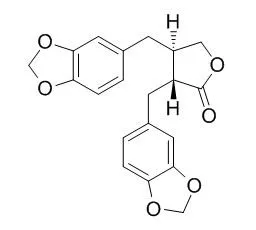| Description: |
(-)-Hinokinin has anti-genotoxic and anticarcinogenic potential. (-)-Hinokinin is an anti-chagasic drug, has no mutagenic effects in animal cell and bacterial systems, anxiety that target the DAT, NET, and GAT-1 transporters, it may serve as a tool to develop new therapeutic drugs for attention deficit hyperactivity disorder.
|
| In vitro: |
| J Nat Prod. 2013 Oct 25;76(10):1889-95. | | The lignan (-)-hinokinin displays modulatory effects on human monoamine and GABA transporter activities.[Pubmed: 24112084] | The interaction with neurotransmitter transporters was characterized for a derivative of the lignan (-)-cubebin (1), namely, (-)-Hinokinin (2).
METHODS AND RESULTS:
Using in vitro pharmacological assays, (-)-Hinokinin selectively inhibited the human dopamine and norepinephrine transporters, in a noncompetitive manner possibly mediated by binding to a novel site within the transporters, and displayed low affinity for the serotonin transporter. (-)-Hinokinin also specifically inhibited the GAT-1 GABA transporter subtype. (-)-Hinokinin is not a substrate of the carriers as it had no effect on the efflux of either of the neurotransmitters investigated. This compound is inactive toward glutamate and glycine transporters.
CONCLUSIONS:
These results suggest that (-)-Hinokinin may serve as a tool to develop new therapeutic drugs for ADHD and anxiety that target the DAT, NET, and GAT-1 transporters. | | BMC Complement Altern Med. 2012 Oct 31;12:203. | | Mutagenicity and antimutagenicity of (-)-hinokinin a trypanosomicidal compound measured by Salmonella microsome and comet assays.[Pubmed: 23114276] | The dibenzylbutyrolactone lignan (-)-Hinokinin (HK) was derived by partial synthesis from (-)-cubebin, isolated from the dry seeds of the pepper, Piper cubeba. Considering the good trypanosomicidal activity of (-)-Hinokinin and recalling that natural products are promising starting points for the discovery of novel potentially therapeutic agents, the aim of the present study was to investigate the (anti) mutagenic∕ genotoxic activities of (-)-Hinokinin.
METHODS AND RESULTS:
The mutagenic∕ genotoxic activities were evaluated by the Ames test on Salmonella typhimurium strains TA98, TA97a, TA100 and TA102, and the comet assay, so as to assess the safe use of (-)-Hinokinin in the treatment of Chagas' disease. The antimutagenic ∕antigenotoxic potential of (-)-Hinokinin were also tested against the mutagenicity of a variety of direct and indirect acting mutagens, such as 4- nitro-o-phenylenediamine (NOPD), sodium azide (SA), mitomycin C (MMC), benzo[a]pyrene (B[a]P), aflatoxin B1 (AFB1), 2-aminoanthracene (2-AA) and 2-aminofluorene (2-AF), by the Ames test, and doxorubicin (DXR) by the comet assay. The mutagenicity∕genotoxicity tests showed that (-)-Hinokinin did not induce any increase in the number of revertants or extent of DNA damage, demonstrating the absence of mutagenic and genotoxic activities. On the other hand, the results on the antimutagenic potential of (-)-Hinokinin showed a strong inhibitory effect against some direct and indirect-acting mutagens.
CONCLUSIONS:
Regarding the use of (-)-Hinokinin as an antichagasic drug, the absence of mutagenic effects in animal cell and bacterial systems is encouraging. In addition, (-)-Hinokinin may be a new potential antigenotoxic ∕ antimutagenic agent from natural sources. However, the protective activity of (-)-Hinokinin is not general and varies with the type of DNA damage-inducing agent used. |
|
| In vivo: |
| J Nat Prod. 2014 Oct 24;77(10):2312-5. | | Chemopreventive effects of (-)-hinokinin against 1,2-dimethylhydrazine-induced genotoxicity and preneoplastic lesions in rat colon.[Pubmed: 25297647] |
METHODS AND RESULTS:
(-)-Hinokinin (1) is a dibenzylbutyrolactone lignan obtained by the partial synthesis of (-)-cubebin. This study reports the antigenotoxic and anticarcinogenic potential of 1 by the comet and aberrant crypt focus assays in the peripheral blood and colon of 4-5-week-old Wistar rats, respectively. The rats were exposed to 1,2-dimethylhydrazine (40 mg/kg) and were treated by gavage with doses of 10, 20, and 40 mg/kg of 1.
CONCLUSIONS:
The results showed that the dose of 40 mg/kg was neither genotoxic nor carcinogenic. In the comet assay, all 1 doses displayed antigenotoxic effects. In addition, this compound (20 and 40 mg/kg) exhibited an anticarcinogenic effect in the aberrant crypt focus assay. | | Exp Parasitol. 2013 Apr;133(4):442-6. | | Evaluation of the in vivo therapeutic properties of (-)-cubebin and (-)-hinokinin against Trypanosoma cruzi.[Pubmed: 23274812] | Even though the Chagas' disease, caused by the protozoan Trypanosoma cruzi, was described 100years ago by Carlos Chagas, it still represents a major public health concern and is found in 18 developing countries in South and Central America. In Brazil, Benznidazole (Rochagan) is the only drug with trypanocidal activity available in the market, despite its several side effects and limited efficacy in the chronic phase of the infection.
METHODS AND RESULTS:
In view of the need for new substances displaying biological activity against T. cruzi, there has been growing interest in research toward the attainment of compounds capable of acting on the parasite while being devoid of serious side effects. In this context, this study aims to evaluate the in vivo therapeutic activity of dibenzylbutyrolactone lignans (-)-cubebin and (-)-Hinokinin during the acute phase of infection by T. cruzi. As a study criterion, animals with acute parasitemia were investigated by tissue morphometric analysis. There was significant parasitemia reduction in the groups of animals treated with (-)-cubebin or (-)-hinokin oral administration, compared to the negative control.
CONCLUSIONS:
Values close to those of the uninfected control were found in the groups treated with (-)-cubebin and (-)-Hinokinin via kariometry, showing that there was positive cellular response compared to the infected control. |
|






 Cell. 2018 Jan 11;172(1-2):249-261.e12. doi: 10.1016/j.cell.2017.12.019.IF=36.216(2019)
Cell. 2018 Jan 11;172(1-2):249-261.e12. doi: 10.1016/j.cell.2017.12.019.IF=36.216(2019) Cell Metab. 2020 Mar 3;31(3):534-548.e5. doi: 10.1016/j.cmet.2020.01.002.IF=22.415(2019)
Cell Metab. 2020 Mar 3;31(3):534-548.e5. doi: 10.1016/j.cmet.2020.01.002.IF=22.415(2019) Mol Cell. 2017 Nov 16;68(4):673-685.e6. doi: 10.1016/j.molcel.2017.10.022.IF=14.548(2019)
Mol Cell. 2017 Nov 16;68(4):673-685.e6. doi: 10.1016/j.molcel.2017.10.022.IF=14.548(2019)